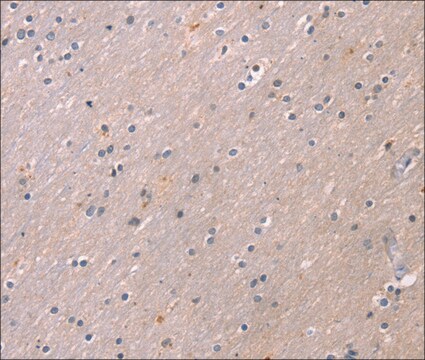K0514
Anti-KCNK9 (TASK-3) antibody, Mouse monoclonal
clone KCN-75, purified from hybridoma cell culture
About This Item
Polecane produkty
pochodzenie biologiczne
mouse
białko sprzężone
unconjugated
forma przeciwciała
purified from hybridoma cell culture
rodzaj przeciwciała
primary antibodies
klon
KCN-75, monoclonal
Postać
buffered aqueous solution
masa cząsteczkowa
antigen ~40 kDa (representing the KCNK9 monomer, and a weaker band at 80 kDa representing the KCNK9 dimer)
reaktywność gatunkowa
human
metody
immunocytochemistry: suitable
indirect ELISA: suitable
microarray: suitable
western blot: 4-8 μg/mL using whole extract of cultured T-47D cells (human breast carcinoma)
izotyp
IgG2b
numer dostępu UniProt
Warunki transportu
dry ice
temp. przechowywania
−20°C
docelowa modyfikacja potranslacyjna
unmodified
informacje o genach
human ... KCNK9(51305)
Powiązane kategorie
Opis ogólny
Immunogen
Zastosowanie
- immunoblotting
- immunohistochemistry
- immunocytochemistry
Działania biochem./fizjol.
Postać fizyczna
Oświadczenie o zrzeczeniu się odpowiedzialności
Not finding the right product?
Try our Narzędzie selektora produktów.
Kod klasy składowania
10 - Combustible liquids
Klasa zagrożenia wodnego (WGK)
nwg
Temperatura zapłonu (°F)
Not applicable
Temperatura zapłonu (°C)
Not applicable
Certyfikaty analizy (CoA)
Poszukaj Certyfikaty analizy (CoA), wpisując numer partii/serii produktów. Numery serii i partii można znaleźć na etykiecie produktu po słowach „seria” lub „partia”.
Masz już ten produkt?
Dokumenty związane z niedawno zakupionymi produktami zostały zamieszczone w Bibliotece dokumentów.
Nasz zespół naukowców ma doświadczenie we wszystkich obszarach badań, w tym w naukach przyrodniczych, materiałoznawstwie, syntezie chemicznej, chromatografii, analityce i wielu innych dziedzinach.
Skontaktuj się z zespołem ds. pomocy technicznej






